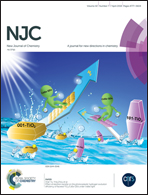Structural investigations on uranium(vi) and thorium(iv) complexation with TBP and DHOA: a spectroscopic study†
Abstract
Spectroscopic studies were carried out to understand the complexation of U(VI) and Th(IV) with tri-butyl phosphate (TBP) and N,N-dihexyl octanamide (DHOA) in different non-aqueous solvents. The observations from the various spectroscopic studies (FTIR, TRFS and/or UV-Vis spectroscopy) of Th(IV)–L and U(VI)–L (L: DHOA/TBP) were correlated with the EXAFS data. The combined FTIR and EXAFS studies for Th(IV)–L and U(VI)–L extracted complexes suggested strong nitrate binding, in the presence of the ligand (TBP/DHOA), in the latter case. The peak positions of the phosphoryl oxygen of TBP for Th(IV) and U(VI) binding were at 1178 cm−1 and 1184 cm−1, suggesting stronger complexation with Th(IV) as compared to U(VI). The nitrate ion binding as well as the symmetry of the nitrate ions were in conformity with the EXAFS and FTIR data. The difference in the U(VI) UV-vis and luminescence spectra of the two complexes in a given medium was explained from the symmetry of the formed complexes in the non-aqueous media. The differences in the UV-absorption spectra of the U(VI)–L complexes in n-dodecane were correlated with the difference in the relative arrangement of nitrates and the ligands’ approach in the two cases as seen by the combined study of EXAFS and FTIR. The coordination ability of DHOA was found to be superior to that of TBP for U(VI) in the studied solvents.



 Please wait while we load your content...
Please wait while we load your content...